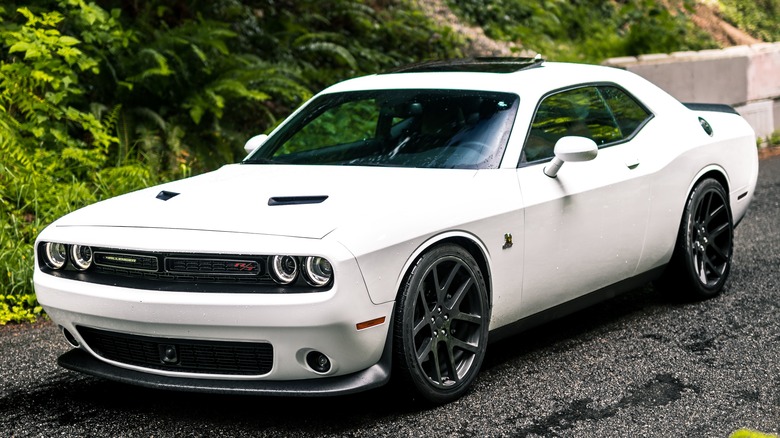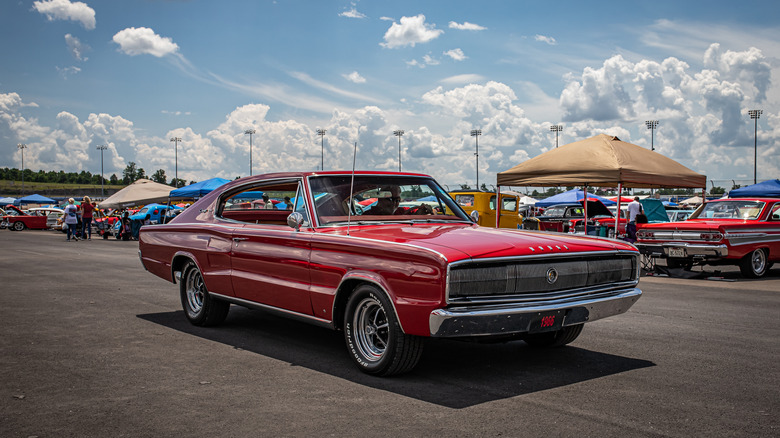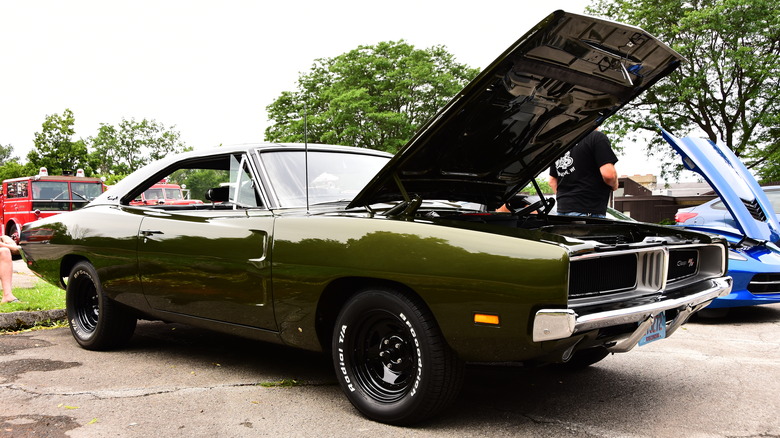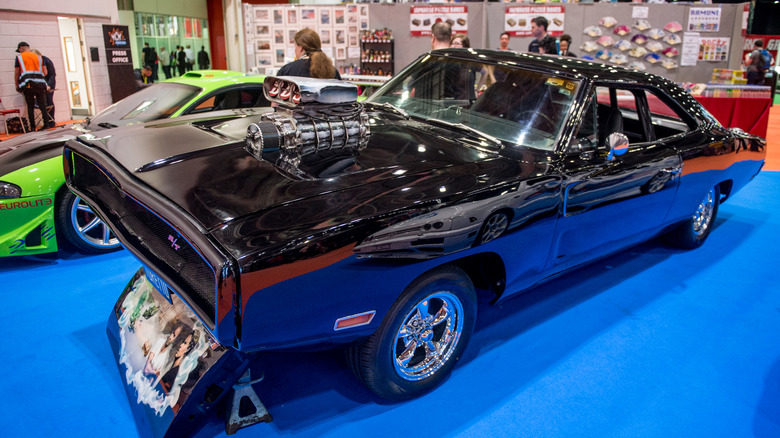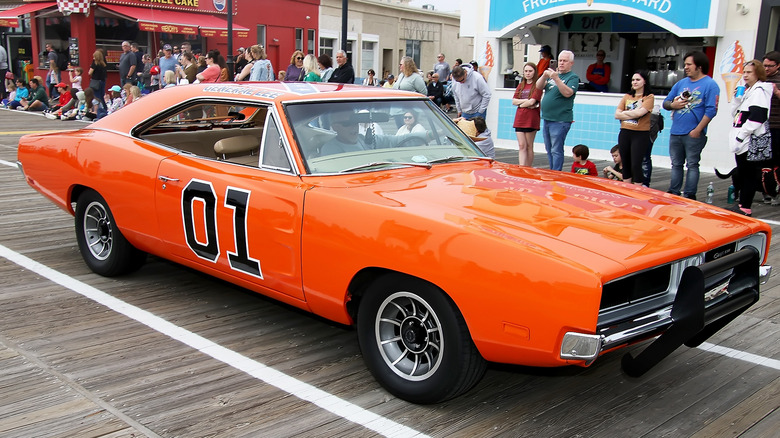A Closer Look At What Helped The Dodge Charger R/T Rise To Fame
With almost any vehicle purchase, trim selections are important to look into. Considerations like your budget, the particular features added (or omitted) with a specific trim, and the practical impact such features are likely to have on the way you drive need to be carefully mulled over. After all, nobody wants to spend extra for something that they're unlikely to ever use.
Take Dodge's iconic Charger family, for instance. Boldly venturing into the world of EV muscle cars in March 2024 (essentially the only one that exists currently), it's a brand that seems to have always strived to set itself apart. To continue to do so almost six decades after its introduction is quite a feat, and may never have been possible had the original Dodge Charger R/T not had the impact that it did.
How did everything go so right for Dodge with the R/T, though? The power and performance of the original, the way the R/T evolved over the model years, and the impetus of more than a little attention from Hollywood certainly helped in that regard. The first of these factors we'll explore here is exactly what the original Charger R/T was capable of.
The original Charger and its capabilities
The Dodge Charger made its debut in style in 1964, an auto show spectacle that consisted of a specially adapted Polara. A primary purpose for its existence was to show off the 426 Chrysler HEMI. As it happened, completed units of this engine were in such short supply that there wasn't one available to put inside this one-off model, but that didn't matter. The public had met the Charger, and it would go on to become a true auto icon.
Dodge had enough faith in the new vehicle to go right ahead with production, and it would go on sale late in 1965 in the US. Despite the cachet the Charger family would later enjoy, the public didn't seem to take to the Charger very much at first. Just 37,300 of the 1966 model year Charger were sold (around 16 times more Ford Mustangs sold in the same period).
Nevertheless, it established itself as a formidable vehicle, its baseline V-8 engine with a 230 bhp output absolutely allowing it to muscle its way into the muscle car arena with the option for that 426 Hemi engine offering 425 bhp. However, the Charger family had much more to offer, and particular factors would make the R/T a hit.
A targeted redesign for the second generation
One major thing the original Dodge Charger lacked, of course, was hindsight. It's incredibly difficult to get every aspect of a product right from the very first attempt, particularly in the case of an aspect as fundamental as the design itself. With cars, appearances are crucial, and the classic fastback curving roof may have been a factor in its underwhelming performance. The Charger's creators, however, soon set about designing a model intended to capture the imaginations of drivers who weren't enamored with the Charger the first time around.
Incorporating hints of other established vehicles' aesthetics, such as the Ford Mustang-esque placement of the sizable bumpers, the second generation of the Charger could be deemed rather more visually appealing. Blending familiarity with something new is a reassuring yet intriguing tactic, and it was an important step in truly bringing the vehicle family into the limelight. Compared to its debut year's disappointing sales, it hit vastly improved 1968 sales numbers. 17,584 Dodge Charger R/Ts sold that year, with the Charger selling approximately 100,000 overall.
The model's fortunes had certainly improved, but for the stars to align for the R/T, it would take more than just an interior and exterior redesign. Luckily for the brand, then, something else happened in 1968: A particular movie featured a very specific scene, which involved a Charger R/T. That scene would leave quite the impression.
Faster (and more furious) than a speeding Bullitt: The Dodge Charger R/T became a movie star
A muscle car's image is all about being powerful, rugged, substantial, and maybe more than a little rebellious. It would be quite a PR blessing, then, for such a vehicle to appear in a high-profile movie car chase. This is exactly what happened in "Bullitt," a 1968 movie featuring a legendary chase scene that elevated the status of not just one but two different brands of vehicle.
This car chase takes place between a Ford Mustang driven by the one and only Steve McQueen and a Dodge Charger R/T driven by the villains that were being pursued by McQueen's character, San Francisco's Lieutenant Frank Bullitt. Three different Dodge Charger R/T 400 models were prepared to serve as the vehicle of choice for Bullitt's enemies. Interestingly, behind the scenes, this was not the first choice of vehicle for the role. A Galaxie 500 was in contention too (what a Ford-versus-Ford setup that would have been), but Hagerty reports that the Galaxie was ultimately considered not up to the rigors of the chase.
With "Bullitt" making more than $42.3 million worldwide, plenty of people across the globe got to see that Charger R/T -– painted a non-standard black that upped the cool factor further -– in action (action being the operative word). In the early 2000s, another Charger R/T would become a Hollywood hero in Vin Diesel's hands.
The R/T's movie legacy continues
Being seen tearing around San Francisco in "Bullitt," as we've seen, surely contributed to the approximately 100,000 sales that the 1960 Dodge Charger enjoyed. Less than one-quarter of those were R/Ts, but raising the profile of the Charger family was very valuable for the company.
If the "Fast & Furious" movie series is known for anything, it's for absurdly fast vehicles performing equally absurd stunts. Vin Diesel's Dominic Toretto, as the de facto protagonist of the series, needed a vehicle that reflected all of that. Of course, he'd go on to drive all sorts of speed machines as the movies went on (and Vin Diesel himself owns a considerable selection that includes the likes of the powerful Pontiac Bonneville), but the one most frequently attributed to him would probably be his beloved Dodge Charger R/T, which made its debut in 2001's "The Fast and the Furious."
Toretto's R/T, which was also black, was a unique vehicle. Not technically the 1970 model it purported to be, it was actually modified from a 1969 Charger for convenience's sake. For the big screen, it was further augmented with a unique supercharger and 200-s Cragars, not to mention an engine reportedly capable of topping 900 horsepower. The vehicle takes on an almost mythical quality in 2001's series debut "The Fast & the Furious," and though commercially available R/T's weren't quite the same as their movie counterpart, the latter surely galvanized further interest in the former.
The Dodge Charger R/T's legacy
The General Lee of "The Dukes of Hazzard" fame is also an adapted Dodge Charger. Ahead of the release of the eponymous movie adaptation in 2005, a Kelley Blue Brook press release noted that '69 Charger fever was in overdrive again. In July 2005, the value of the '69 Charger R/T jumped to $43,900, having started the year at just over $28,000. The then-upcoming movie was tied to the leap in the vehicle's value, Kelley Blue Brook executive market analyst and editorial director Jack R. Nerad stated, because "The collector car market reflects [...] popular culture."
From "Dukes of Hazzard" to "Bullitt" and "The Fast & the Furious," pop culture has been a massive part of the R/T's appeal for decades. The Charger didn't have the most auspicious beginning, with a meager 15,788 assemblies in 1967, but redesigns can go a very long way. The 1968 Charger topped 96,000. The Charger family would go on to other successes too, with the Dodge Charger Daytona claiming some high-profile victories in 1969 at the Talladega NASCAR Grand National and Texas International Speedway.
Kelley Blue Book's Jack R. Nerad concludes that the Charger is "a quintessential example of the American muscle car," and the Road/Track trim that debuted with the 1967 Cornet marked a new level of power for it. This helped cement it as a formidable vehicle worthy of both the movies and drivers' enduring affection.
